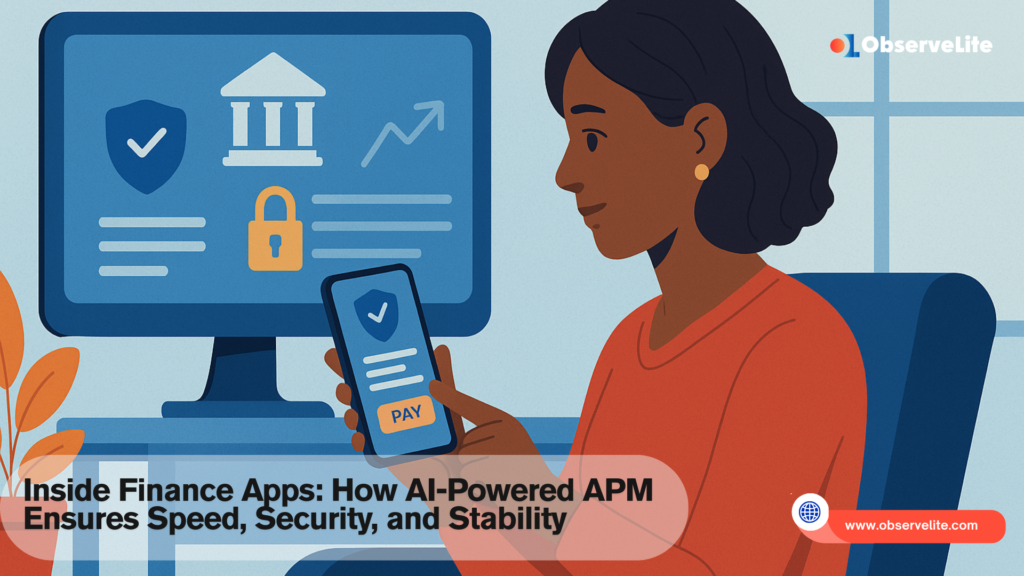Finance apps have become the primary gateway for millions of people to manage money — from digital wallets and trading apps to payment gateways and lending platforms. In such high-stakes environments, speed, security, and uninterrupted availability are non-negotiable.
Yet, financial service providers often face performance bottlenecks, compliance pressures, and evolving fraud threats. That’s where AI-powered APM in finance apps comes in. Application Performance Monitoring powered by AI doesn’t just track metrics; it predicts outages, detects anomalies, and ensures compliance at scale.
This blog explores how financial service providers can safeguard customer trust and operational stability by adopting APM solutions built for the modern financial ecosystem.
How Can AI Predict Outages in Finance Apps Before Customers Notice?
Unplanned outages don’t just frustrate users — they erode trust, disrupt transactions, and can even trigger regulatory scrutiny. AI-powered APM systems use predictive analytics to spot early warning signs, such as:
- Spikes in transaction response times
- Server utilization trends nearing thresholds
- Database query slowdowns
By analyzing patterns across thousands of real-time transactions, AI models can forecast potential failures. Finance app operators gain time to respond before downtime impacts the customer, protecting both experience and reputation.
What ML Models Best Detect Performance Anomalies in Financial Transactions?
Financial transactions happen at high volume and velocity, making anomaly detection a complex task. Machine learning (ML) models such as:
- Supervised models trained on past incidents to detect known performance issues
- Unsupervised models that flag unusual behavior (e.g., sudden transaction spikes in off-hours)
- Deep learning networks for advanced fraud or latency anomaly recognition
These models work together to help financial services apps maintain both speed and compliance, ensuring subtle risks are flagged instantly.
How Does Synthetic Monitoring with AI Improve User Experience in Finance Apps?
Customer experience is everything in finance. Synthetic monitoring simulates user actions — from logging into a wallet to making a payment — under different conditions.
AI enhances this by:
- Testing across geographies, devices, and network strengths
- Predicting where UX may break down (e.g., failed biometric logins)
- Ensuring smooth onboarding even during peak demand
This proactive monitoring helps financial apps resolve UX bottlenecks before they affect real users.
What Causes False Positives in AI-Driven APM for Finance Systems?
While AI reduces error rates, false positives still occur. Common causes include:
- Noisy datasets leading to over-flagging
- Overly strict thresholds tuned too tightly
- Untrained scenarios like newly launched features
Reducing false positives requires continuous learning loops where operators validate alerts and models self-improve, striking a balance between vigilance and efficiency.
How Will AI APM Change Incident Response Workflows in Finance?
Traditional incident response is reactive. With AI-powered APM, response becomes predictive and automated:
- Root cause analysis in seconds instead of hours
- Automated remediation (e.g., scaling servers, rerouting traffic)
- Prioritization of critical services like payments and trading executions
This allows IT teams in finance to spend less time firefighting and more time on strategic innovation.
Which APM Features Are Most Critical for Real-Time Finance Apps?
Not all features are equally important in finance apps. The most critical include:
- End-to-end transaction tracing for fraud and performance visibility
- Real-time SLA dashboards for payment and trading services
- Compliance-ready audit trails integrated into monitoring
- Anomaly detection at both infrastructure and transaction levels
Together, these features ensure both operational resilience and regulatory readiness.
How Do Synthetic and Real-User Monitoring Compare for Finance Apps?
- Synthetic monitoring = simulated tests (best for pre-release checks)
- Real-user monitoring (RUM) = live user data (best for production insights)
AI-powered APM combines both, ensuring issues are predicted in test environments and validated in live usage, offering a complete view of app reliability.
What Causes API Latency Spikes During Peak Financial Transactions?
APIs drive financial apps — from payments to lending approvals. Latency spikes often happen due to:
- High request volumes during payroll or market hours
- Poor microservice load balancing
- Third-party API inefficiencies
AI APM tools detect patterns in API delays and recommend fixes — from rebalancing workloads to pre-scaling resources — ensuring smooth high-volume processing.
How Will Predictive ML in APM Reduce Missed SLAs in Finance?
Strict SLAs govern payments, trading, and compliance. Predictive ML helps by:
- Forecasting demand surges (e.g., market openings, salary deposits)
- Triggering alerts before SLA breaches
- Auto-scaling infrastructure in real time
This reduces SLA violations and strengthens client confidence.
How Can Finance Teams Prioritize APM Alerts to Avoid Alert Fatigue?
Floods of alerts can overwhelm finance IT teams. AI-driven prioritization ensures focus:
- Severity tagging for customer-impacting issues
- Incident correlation to avoid duplicate alerts
- Business-aligned dashboards for critical transaction flows
This reduces noise and ensures focus on continuity-critical issues.
Frequently Asked Questions
Q1. What is AI-powered APM in finance apps?
It’s the use of AI-driven monitoring tools to predict, detect, and resolve performance, security, and compliance issues in financial applications.
Q2. How does it improve security in finance apps?
By spotting anomalies in transactions, detecting fraud attempts, and monitoring data integrity across APIs.
Q3. Can AI-powered APM reduce downtime in financial services?
Yes. Predictive alerts and automated remediation minimize disruptions.
Q4. Is AI-powered APM necessary for compliance in finance apps?
Absolutely. It provides audit trails, SLA adherence, and monitoring aligned with financial regulations.
Q5. What’s the difference between synthetic and real-user monitoring?
Synthetic = simulations, RUM = real user data. Combined, they ensure performance reliability.
Conclusion
The growth of financial services apps means users expect speed, stability, and security 24/7. Regulators, meanwhile, demand tighter compliance and transparency. AI-powered APM in finance apps delivers across all dimensions: preventing outages, detecting anomalies, reducing fraud, and ensuring compliance.
For financial services providers, this isn’t just about performance — it’s about survival in a hyper-competitive market. Those who adopt advanced APM now will set themselves apart in reliability and customer trust.Platforms like ObserveLite’s APM are already enabling financial services companies to achieve this balance of speed, security, and compliance, setting a new benchmark for digital finance.


